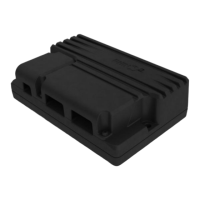Chapter 4: Programming the Rhino2
4.4.5.3 ThermalRollbackStart / End
Thermal rollback provides protection for the controller against overheating. The values of
these two parameters set the range for when the thermal rollback starts
(ThermalRollbackStart), and ends (ThermalRollbackEnd).
When the controller temperature exceeds ThermalRollbackStart and is less than the upper
temperature limit ThermalRollbackEnd, the controller rolls back the demand, load
compensation and current limit in order to control the temperature rise to protect the
controller against overheating. As the temperature falls back within this range, the control
allows the demand, load compensation and current limit to recover.
4.4.5.4 Motor Reverse
Yes - The polarity of the motor pins on the RHINO2 is reversed and the motor turns in the
opposite direction.
No - The polarity of the motor pins is as described in section 3.5.
Note:
Do not use Motor Reverse to setup the scooter for left-handed use, set the
Swap Throttle Direction parameter (see 4.4.1.3) to 'Yes' instead. Motor Reverse only
swaps the motor polarity, not other forward/reverse features such as the
Forward/Reverse speed setting and the reversing beeper. Using Motor Reverse to
setup the scooter for left-handed use will result in the reversing beeper beeping
while the scooter drives forward.
4.4.5.5 Load Compensation
DS90:
60mΩ
DS120:
40mΩ
DS160:
28mΩ
Load Compensation automatically compensates for changes in motor speed when the
scooter drives over loads such as sidewalks, curbs or slopes. Set Load Compensation to 'Yes' for
normal operation.
Note:
The Load Compensation parameter affects the performance of all other speed
and acceleration parameters, and it is important to set this parameter correctly
before you program these parameters. If the Load Compensation parameter is
changed after the scooter has been set up, the complete speed/acceleration
programming and testing procedure must be repeated.

